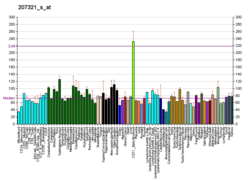ABCB9
ATP-binding cassette sub-family B member 9 is a protein that in humans is encoded by the ABCB9 gene.[5][6]
The membrane-associated protein encoded by this gene is a member of the superfamily of ATP-binding cassette (ABC) transporters. ABC proteins transport various molecules across extra- and intra-cellular membranes. ABC genes are divided into seven distinct subfamilies (ABC1, MDR/TAP, MRP, ALD, OABP, GCN20, White). This protein is a member of the MDR/TAP subfamily. Members of the MDR/TAP subfamily are involved in multidrug resistance as well as antigen presentation. The function of this half-transporter has not yet been determined; however, this protein may play a role in lysosomes. Alternative splicing of this gene results in distinct isoforms which are likely to have different substrate specifications.[6]
See also
References
- 1 2 3 GRCh38: Ensembl release 89: ENSG00000150967 - Ensembl, May 2017
- 1 2 3 GRCm38: Ensembl release 89: ENSMUSG00000029408 - Ensembl, May 2017
- ↑ "Human PubMed Reference:".
- ↑ "Mouse PubMed Reference:".
- ↑ Allikmets R, Gerrard B, Hutchinson A, Dean M (Feb 1997). "Characterization of the human ABC superfamily: isolation and mapping of 21 new genes using the expressed sequence tags database". Hum Mol Genet. 5 (10): 1649–55. doi:10.1093/hmg/5.10.1649. PMID 8894702.
- 1 2 "Entrez Gene: ABCB9 ATP-binding cassette, sub-family B (MDR/TAP), member 9".
Further reading
- Bonaldo MF, Lennon G, Soares MB (1997). "Normalization and subtraction: two approaches to facilitate gene discovery". Genome Res. 6 (9): 791–806. doi:10.1101/gr.6.9.791. PMID 8889548.
- Zhang F, Zhang W, Liu L, et al. (2000). "Characterization of ABCB9, an ATP binding cassette protein associated with lysosomes". J. Biol. Chem. 275 (30): 23287–94. doi:10.1074/jbc.M001819200. PMID 10748049.
- Nagase T, Kikuno R, Ishikawa K, et al. (2000). "Prediction of the coding sequences of unidentified human genes. XVII. The complete sequences of 100 new cDNA clones from brain which code for large proteins in vitro". DNA Res. 7 (2): 143–50. doi:10.1093/dnares/7.2.143. PMID 10819331.
- Kobayashi A, Kasano M, Maeda T, et al. (2000). "A half-type ABC transporter TAPL is highly conserved between rodent and man, and the human gene is not responsive to interferon-gamma in contrast to TAP1 and TAP2". J. Biochem. 128 (4): 711–8. doi:10.1093/oxfordjournals.jbchem.a022805. PMID 11011155.
- Saito S, Iida A, Sekine A, et al. (2002). "Three hundred twenty-six genetic variations in genes encoding nine members of ATP-binding cassette, subfamily B (ABCB/MDR/TAP), in the Japanese population". J. Hum. Genet. 47 (1): 38–50. doi:10.1007/s10038-002-8653-6. PMID 11829140.
- Strausberg RL, Feingold EA, Grouse LH, et al. (2003). "Generation and initial analysis of more than 15,000 full-length human and mouse cDNA sequences". Proc. Natl. Acad. Sci. U.S.A. 99 (26): 16899–903. doi:10.1073/pnas.242603899. PMC 139241. PMID 12477932.
- Kobayashi A, Hori S, Suita N, Maeda M (2003). "Gene organization of human transporter associated with antigen processing-like (TAPL, ABCB9): analysis of alternative splicing variants and promoter activity". Biochem. Biophys. Res. Commun. 309 (4): 815–22. doi:10.1016/j.bbrc.2003.08.081. PMID 13679046.
- Ota T, Suzuki Y, Nishikawa T, et al. (2004). "Complete sequencing and characterization of 21,243 full-length human cDNAs". Nat. Genet. 36 (1): 40–5. doi:10.1038/ng1285. PMID 14702039.
- Beausoleil SA, Jedrychowski M, Schwartz D, et al. (2004). "Large-scale characterization of HeLa cell nuclear phosphoproteins". Proc. Natl. Acad. Sci. U.S.A. 101 (33): 12130–5. doi:10.1073/pnas.0404720101. PMC 514446. PMID 15302935.
- Gerhard DS, Wagner L, Feingold EA, et al. (2004). "The Status, Quality, and Expansion of the NIH Full-Length cDNA Project: The Mammalian Gene Collection (MGC)". Genome Res. 14 (10B): 2121–7. doi:10.1101/gr.2596504. PMC 528928. PMID 15489334.
- Homma K, Kikuno RF, Nagase T, et al. (2004). "Alternative splice variants encoding unstable protein domains exist in the human brain". J. Mol. Biol. 343 (5): 1207–20. doi:10.1016/j.jmb.2004.09.028. PMID 15491607.
- Wolters JC, Abele R, Tampé R (2005). "Selective and ATP-dependent translocation of peptides by the homodimeric ATP binding cassette transporter TAP-like (ABCB9)". J. Biol. Chem. 280 (25): 23631–6. doi:10.1074/jbc.M503231200. PMID 15863492.
- Kimura K, Wakamatsu A, Suzuki Y, et al. (2006). "Diversification of transcriptional modulation: Large-scale identification and characterization of putative alternative promoters of human genes". Genome Res. 16 (1): 55–65. doi:10.1101/gr.4039406. PMC 1356129. PMID 16344560.
- Ohashi-Kobayashi A, Ohashi K, Du WB, et al. (2006). "Examination of drug resistance activity of human TAP-like (ABCB9) expressed in yeast". Biochem. Biophys. Res. Commun. 343 (2): 597–601. doi:10.1016/j.bbrc.2006.03.002. PMID 16554024.
External links
- ABCB9+protein,+human at the US National Library of Medicine Medical Subject Headings (MeSH)
- Human ABCB9 genome location and ABCB9 gene details page in the UCSC Genome Browser.
This article incorporates text from the United States National Library of Medicine, which is in the public domain.





